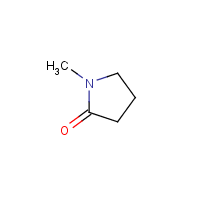N-Methyl-2-pyrrolidone
Agent Name
N-Methyl-2-pyrrolidone
CAS Number
872-50-4
Formula
C5-H9-N-O
Major Category
Solvents

Synonyms
1-Methyl-2-pyrrolidinone; 1-Methyl-2-pyrrolidone; 1-Methyl-5-pyrrolidinone; 1-Methylazacyclopentan-2-one; 1-Methylpyrrolidinone; 1-Methylpyrrolidone; 2-Pyrrolidinone, 1-methyl-; M-Pyrol; Methylpyrrolidone; N-Methyl-2-pyrrolidinone; N-Methyl-2-pyrrolidone; N-Methyl-gamma-butyrolactam; N-Methylpyrrolidinone; N-Methylpyrrolidone; NMP; Norleucine, 5-oxo-, DL; [ChemIDplus] UN1993
Category
Other Solvents
Description
A clear colorless liquid with a fish-like odor; [CAMEO] Almost colorless liquid with an amine odor; [AIHA]
Sources/Uses
Used as a solvent for chemicals and resins in the microelectronics and pharmaceutical industries; [HSDB] Widely used to replace other solvents, e.g., for paint stripping and lube oil extraction; it is used as a solvent for pesticides, coatings, adhesives, dyes, pigments, polymers, and polyurethane foam cleanup. [ACGIH]
Comments
It is absorbed through the skin; a severe eye irritant; [CSH, p. 291] "It is mainly an irritant, but it can cause severe contact dermatitis due to prolonged contact." [Kanerva, p. 1816] Experimental animals experience lethargy and respiratory difficulty after inhalation. [HSDB] Some animal studies found fetal loss and birth defects after high doses during early pregnancy. [Frazier, p. 345] NMP is a cyclic amide used as a solvent, catalyst, formulating agent, and graffiti remover. Significant absorption occurs through the skin. 2-HMSI can be used for biological monitoring of workers. [Akesson B, Carnerup MA, Jonsson BAG. Evaluation of exposure biomarkers from percutaneous absorption of N-methyl-2-pyrrolidone. Scand J Work Environ 2004;30(4):306-312] In high-dose animal studies, adverse effects include CNS depression and changes to the liver, kidneys, and blood cells. [ACGIH] A skin and eye irritant; [ICSC] Danger of cutaneous absorption; [AIHA]
Reference Link #1
Biomedical References
Exposure Assessment
BEI
5-Hydroxy-N-methyl-2-pyrrolidone in urine = 100 mg/L at end of shift;
MAK
20 ppm, (can also occur as vapor and aerosol)
Vapor Pressure
0.345 mm Hg
Odor Threshold Low
4 ppm
Odor Threshold High
10 ppm
Lethal Concentration
LCLo (rat) = 1,000 mg/m3
Explanatory Notes
Flash point = 96 deg C; Odor thresholds from CSH; VP from HSDB;
Reference Link #2
NFPA
high ambient temp required
WEEL
10 ppm
Adverse Effects
Neurotoxin
Acute solvent syndrome
Hepatotoxin
Hepatoxic (a) from occupational exposure (secondary effect) or (b) in animal studies or in humans after ingestion
Reproductive Toxin
Yes
Diseases, Processes, and Activities Linked to This Agent
Diseases
Occupational diseases associated with exposure to this agent:
Processes
Industrial Processes with risk of exposure: